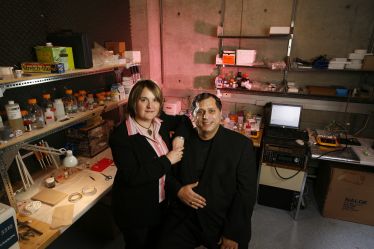Charging Portable Electronics in 10 Minutes

Mihri and Cengiz Ozkan, both professors in the Bourns College of Engineering.
Researchers at the University of California, Riverside Bourns College of Engineering have developed a three-dimensional, silicon-decorated, cone-shaped carbon-nanotube cluster architecture for lithium ion battery anodes that could enable charging of portable electronics in 10 minutes, instead of hours.
Lithium ion batteries are the rechargeable battery of choice for portable electronic devices and electric vehicles. But, they present problems. Batteries in electric vehicles are responsible for a significant portion of the vehicle mass. And the size of batteries in portable electronics limits the trend of down-sizing.
Silicon is a type of anode material that is receiving a lot of attention because its total charge capacity is 10 times higher than commercial graphite based lithium ion battery anodes. Consider a packaged battery full-cell. Replacing the commonly used graphite anode with silicon anodes will potentially result in a 63 percent increase of total cell capacity and a battery that is 40 percent lighter and smaller.
In a paper, Silicon Decorated Cone Shaped Carbon Nanotube Clusters for Lithium Ion Battery Anode,recently published in the journal SMALL, UC Riverside researchers developed a novel structure of three-dimensional silicon decorated cone-shaped carbon nanotube clusters architecture via chemical vapor deposition and inductively coupled plasma treatment.
Lithium ion batteries based on this novel architecture demonstrate a high reversible capacity and excellent cycling stability. The architecture demonstrates excellent electrochemical stability and irreversibility even at high charge and discharge rates, nearly 16 times faster than conventionally used graphite based anodes.
The researchers believe the ultrafast rate of charge and discharge can be attributed to two reasons, said Wei Wang, lead author of the paper.
One, the seamless connection between graphene covered copper foil and carbon nanotubes enhances the active material-current collector contact integrity which facilitates charge and thermal transfer in the electrode system.
Two, the cone-shaped architecture offers small interpenetrating channels for faster electrolyte access into the electrode which may enhance the rate performance.
Wang is a graduate student advised by Cengiz S. Ozkan, a mechanical engineering professor at UC Riverside’s Bourns College of Engineering; and Mihrimah Ozkan, an electrical engineering professor. Both of them are co-authors of the paper.
Other co-authors are Isaac Ruiz, Kazi Ahmed, Hamed Bay, Aaron George, who are all graduate students, and Johnny Wang, an undergraduate student.
Sean Nealon
Tel: (951) 827-1287
E-mail: sean.nealon@ucr.edu
Twitter: seannealon
Media Contact
All latest news from the category: Power and Electrical Engineering
This topic covers issues related to energy generation, conversion, transportation and consumption and how the industry is addressing the challenge of energy efficiency in general.
innovations-report provides in-depth and informative reports and articles on subjects ranging from wind energy, fuel cell technology, solar energy, geothermal energy, petroleum, gas, nuclear engineering, alternative energy and energy efficiency to fusion, hydrogen and superconductor technologies.
Newest articles

Machine learning algorithm reveals long-theorized glass phase in crystal
Scientists have found evidence of an elusive, glassy phase of matter that emerges when a crystal’s perfect internal pattern is disrupted. X-ray technology and machine learning converge to shed light…

Mapping plant functional diversity from space
HKU ecologists revolutionize ecosystem monitoring with novel field-satellite integration. An international team of researchers, led by Professor Jin WU from the School of Biological Sciences at The University of Hong…

Inverters with constant full load capability
…enable an increase in the performance of electric drives. Overheating components significantly limit the performance of drivetrains in electric vehicles. Inverters in particular are subject to a high thermal load,…





















